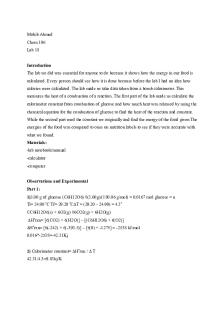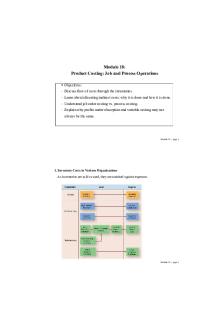WEEK 14-HW-Ch 18 PDF

| Title | WEEK 14-HW-Ch 18 |
|---|---|
| Course | General Biology I |
| Institution | Grand Canyon University |
| Pages | 6 |
| File Size | 298.5 KB |
| File Type | |
| Total Downloads | 17 |
| Total Views | 157 |
Summary
HW Week 14...
Description
Chapter 18
BIO 181: Chapter 18 In class Activity Prokaryotic Gene Regulation 1. Match the following vocabulary terms to their correct definition. A. Binds to the operator to prevent transcription. B. Process by which DNA is converted into RNA C. The product of a metabolic pathway inhibits its own production, when the product is in high concentration. D. In a lac operon, a protein that binds to DNA and stimulates transcription. E. Often found in the promoter, the switch that controls RNA polymerase access to the DNA. F. Stretch of DNA that consists of the promoter and the genes required for protein production. G. A small molecule that cooperates with the repressor protein to switch the operon off. H. In the lac operon this molecule inactivates the repressor. I. The type of operon that is “always” on but can be inhibited under certain conditions. J. The type of operon that is “always” off but can be stimulated under certain conditions. K. This gene produces the repressor. L. Region on the DNA that the RNA polymerase binds to.
__C__Feedback inhibition __L__Promoter __B__Transcription __E__Operator __F__Operon __A__Repressor __G__Corepressor __H__Inducer __K__Regulatory Gene __I__Repressible operon __J__Inducible operon __D__CAP
2. Label the following regions of the operon shown. Promoter, RNA polymerase, operator, genes, mRNA, polypeptides, regulatory gene, and repressor.
Promoter Regulatory gene
mRNA
RNA polymerase
Operator
Polypeptide subunits Inactivation repressor 3. Determine if the 2 images shown are of a repressible operon or an inducible operon. Determine which image is an example of gene expression and which is of gene inactivation. 1. Repressible operon 2. Gene inactivation
A. Inducible operon B. Gene expression
4. Determine if the 2 images shown are of a repressible operon or an inducible operon. Determine which image is an example of gene expression and which is of gene inactivation. -
Repressible operon Gene expression
3. Inducible operon 4. Gene inactivation
5. If a particular operon encodes enzymes for making an essential amino acid and is regulated like the trp operon, then A. the amino acid inactivates the repressor. B. the repressor is active in the absence of the amino acid. C. the amino acid acts as a corepressor. D. the amino acid turns on transcription of the operon. 6. What would occur if the repressor of an inducible operon were mutated so it could not bind the operator? A. irreversible binding of the repressor to the promoter B. reduced transcription of the operon’s genes C. buildup of a substrate for the pathway controlled by the operon D. continuous transcription of the operon’s genes
7. In a prokaryotic cell, what happens to the trp operon, when tryptophan concentrations are low? In prokaryotic cell, the trp operon activates when the tryptophan levels are low by separating of the repressor protein to the operator sequence. It allows the RNA polymerase to transcribe the trp genes in the operon.
8. In a prokaryotic cell, what happens to the trp operon, when tryptophan concentrations are high? In prokaryotic cell, trp operon opens when the level of tryptophan concentration is high. It allows the tryptophan to bind to the repressor and continue the transcription.
9. In a prokaryotic cell, what happens to the lac operon, when lactose concentrations are low? In prokaryotic cell, when the lactose concentrations are low, the lactose operon binds tightly to the operator, preventing transcription by RNA polymerase to happen.
10. In a prokaryotic cell, what happens to the lac operon, when lactose concentrations are high? In prokaryotic cell, the lac repressor loses its ability to bind to the DNA, when there is a high concentration of lactose are present. It floats of the operator, and clearing the ay for the DNA polymerase to transcribe the operon.
BIO 181: Chapter 18 Gene Expression Regulation
Fill in the tables shown on how gene expression can be controlled at each of the following stages.
-
-
-
Genes are highly compacted with genetically not transcribed chromatins. Histones acetylation loosen the chromatin structure, which allows transcription to be enhanced. DNA methylation genetically reduces transcription.
-
-
-
-
-
Each mRNA has a characteristic lifespan that determines in part by sequences in the 5’ to 3’ UTRs.
Regulation of transcription initiation: DNA control elements in enhancers bind specific transcription factors. Bending of the DNA enables activations to contact proteins at the promoter, initiating transcription. Enhancer lives for specific genes.
Allows pre-mRNA to become a mature mRNA, so that they can be translated into a protein. Addition of cap and tail molecules to the two ends of the transcript. Removal introns.
-
Initiation of transcription can be controlled via regulation of initiation factors.
-
Protein processing and degradation are subject to regulation.
1. Which of the following best describes euchromatin and gene expression? A. The DNA is tightly compact and transcription occurs easily. B. The DNA is loosely compact and transcription occurs easily. C. The DNA is loosely compact and transcription does not occur easily. D. The DNA is tightly compact and transcription does not occur easily. 2. Histone Acetylation results in which of the following? A. The DNA becomes more tightly compact and transcription will not occur. B. The DNA becomes loose and transcription will not occur. C. The DNA becomes more tightly compact and transcription will occur. D. The DNA becomes loose and transcription will occur. 3. Which statement best describes transcription factors? A. Transcription factors encourage transcription. B. Transcription factors inhibit transcription. C. Transcription factors encourage translation. D. Transcription factors inhibit translation. 4. All of the following are ways in which to control gene expression at the RNA level except. A. Splicing B. Alternative splicing C. siRNAs D. DNA methylation 5. The proteasome controls gene expression at which level. A. DNA B. RNA C. mRNA D. Protein 6. Muscle cells differ from nerve cells mainly because they A. express different genes. B. contain different genes. C. use different genetic codes. D. have unique ribosomes.
7. Which of the following is an example of post-transcriptional control of gene expression? A. the addition of methyl groups to cytosine bases of DNA B. the binding of transcription factors to a promoter C. the removal of introns and alternative splicing of exons D. gene amplification contributing to cancer 6. What would occur if the repressor of an inducible operon were mutated so it could not bind the operator? A.
irreversible binding of the repressor to the promoter
B.
reduced transcription of the operon’s genes
C.
buildup of a substrate for the pathway controlled by the operon
D.
continuous transcription of the operon’s genes...
Similar Free PDFs

WEEK 14-HW-Ch 18
- 6 Pages

WEEK 14-HW-Ch 18 - Work
- 6 Pages

Matching Week 1 pp. 18-19
- 2 Pages

18 - lab 18
- 4 Pages

18 - Lecture notes 18
- 5 Pages

TEMA 18 - Apuntes 18
- 3 Pages

Chapter 18 - Lecture notes 18
- 21 Pages

Chapter 18 - Lecture notes 18
- 14 Pages

Module 18 - Lecture notes 18
- 41 Pages

Chapter 18 - Lecture notes 18
- 26 Pages

Pregunta 2 18 / 18 ptos
- 12 Pages

Tema 18. Higado - Apuntes 18
- 17 Pages

Chapter 18 - Lecture notes 18
- 13 Pages
Popular Institutions
- Tinajero National High School - Annex
- Politeknik Caltex Riau
- Yokohama City University
- SGT University
- University of Al-Qadisiyah
- Divine Word College of Vigan
- Techniek College Rotterdam
- Universidade de Santiago
- Universiti Teknologi MARA Cawangan Johor Kampus Pasir Gudang
- Poltekkes Kemenkes Yogyakarta
- Baguio City National High School
- Colegio san marcos
- preparatoria uno
- Centro de Bachillerato Tecnológico Industrial y de Servicios No. 107
- Dalian Maritime University
- Quang Trung Secondary School
- Colegio Tecnológico en Informática
- Corporación Regional de Educación Superior
- Grupo CEDVA
- Dar Al Uloom University
- Centro de Estudios Preuniversitarios de la Universidad Nacional de Ingeniería
- 上智大学
- Aakash International School, Nuna Majara
- San Felipe Neri Catholic School
- Kang Chiao International School - New Taipei City
- Misamis Occidental National High School
- Institución Educativa Escuela Normal Juan Ladrilleros
- Kolehiyo ng Pantukan
- Batanes State College
- Instituto Continental
- Sekolah Menengah Kejuruan Kesehatan Kaltara (Tarakan)
- Colegio de La Inmaculada Concepcion - Cebu


